More to See >>
Progress of Ross's Project | Ross Notes | The Exhibit
By Thom Ross
Photos courtesy Patrick Bennett
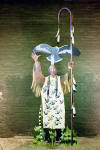
"Sitting Bull"
The great warrior/mystic man of the Hunkpapa Lakota
(Sioux) tribe. He was past his prime at the time of the Custer fight and
took no part in the battle. He stayed in the village and organized the
women and children flight from the area. However, his presence was
undoubtedly felt on the battlefield by his people
so I am going to include him in my installation. He holds a "crook" in
his left hand which served the same purpose as a flag or as a symbol of
authority.
Above him flies a prairie falcon.
On his shirt I have painted his famous vision. The story goes like this:
In the weeks before the Custer fight, Sitting Bull performed a "sun
dance." He had his brother cut 50 pieces of flesh from each arm and then
he danced while facing the sun for three days. He finally collapsed and
had a vision. This vision showed many soldiers falling up-side down into
his camp, and a voice said "I give you these because they have no ears."
Sitting Bull took this to mean that there would be a big fight and that
they would win. So, on his shirt you can see the soldiers falling from
the sky, up-side down. Included in my rendition is a long-haired Custer,
branishing a sword (neither of which he
had at the fight.)
There is a strange incident that mimics this vision of Sitting Bull. As
the troopers left Ft Abraham Lincoln in North Dakota, they were
accompanied by many auxilary settlers and many of their wives. When it
came time to leave these non-combatants behind, Custer leaned from his
saddle and kissed his wife
goodbye. The troops then moved out and Libbie Custer saw a strange
thing. In an atmospheric fluke, she saw the troops reflected up-side down
in the sky above them! I have always wondered if this was what Sitting
Bull saw, though he was hundreds of miles away at the time.

"Crow Scouts"
As Custer and his 5 companies approached the Indian
village down Medicine Tail Coulee, he halted the troops and a small group
rode to the bluffs overlooking the Little Bighorn River. Custer then
returned to his men and sent his second, and final, messenger back
appealing for help from Capt. Benteen who was far in the rear.
Three Crow scouts, White Man Runs Him, Hairy Moccassin, and Goes Ahead,
stood on the bluffs and fired randomly into the village. As Custer and
the doomed troopers moved out, these three scouts rode back the way they
had come and they hooked up with Reno and Benteen's men who were now
besieged by Indians. Eventually, these three Crows melted away and rode
back towards their home. On their way, they bumped into a 4th Crow scout,
Curly, who had continued on with Custer but had ridden away as the battle
began. Curly had witnessed the fight from a distant butte.
This quartet rode north and ran into General Terry's command and, using
sign language, communicated the first word of the disaster to the stunned
soldiers.
In my installation I will place Curly on a distant knoll, watching the
fight. The 3 other Crow scouts seen in thsi attachment will be placed on
the bluffs overlooking the river, almost in the exact spot where they
stood 129 years ago!
My studio assistant, Guy Watkins, calls these three figures the "3
Tenors." I have done 3 cut-out horses for them which will be placed
behind the three Crow scouts.
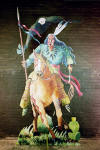
"High Eagle"
Lakota warrior shown riding into the battle with his
power spirit, a bald eagle, flying with him.
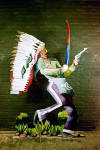
"Young Little
Wolf"
Cheyenne warrior, Young Little Wolf, is seen here running
into the battle carrying the red and blue painted saber that his uncle had
given him in honor of counting two coup on Shoshoni enemies. During the
battle Young Little Wolf lost the saber. He died in 1927.
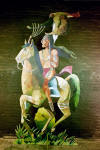
"Hawk Man"
Hawk Man was a Hunkpapa Lakota warrior; this shows him
riding into the battle with his power spirit, the hawk, flying above him.
Sadly, the spiritual powers failed him that day and he was killed in the
battle.

"Tom Custer"
The third Custer brother after George and Nevin -- first
man to win 2 Congressional Medals of Honor...only man so awarded in Civil
War...remains to this day the only double award winner in US
Cavalry. Captain of Company C he fell near his brother, George, at the
Little Bighorn.

"Lt. James
Calhoun"
Married to Margaret Custer, sister of George. Owed his
appointment to the 7th Cavalry to George
Custer. Upon being given his commission in the 7th, Calhoun wrote a
letter to Custer saying that when the time came he would not be found
lacking. He was true to his word. Commanding Co. L he fell with his
troops about 400 yards from Custer.
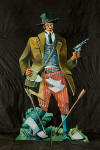
"Mark Kellogg"
Brought along by Custer against specific orders,
Kellogg was a correspondent for the Bismark (ND) Tribune. He sent
dispatches back to his newspaper keeping readers abreast to the
campaign. His
marker is on the back side of Last Stand hill although the men who found
his body claim it was located down near the river.

"Lt. Col. George
Custer"
A general at the age of 23, he fought throughout the
Civil War. After the surrender at Appomattox, Sheridan bought the table
that Grant had written the surrender terms on and awarded it to Custer as
a gift for his wife, Libbie, with a note that said no man was more
responsible for the successful outcome of the Civil War then George
Custer. He died at the Little Bighorn when he was 36.

"Boston Custer"
Youngest brother, Boston Custer, had tagged along with
his other brothers, Tom and George, as a civilian "packer" on the
expedition. Only 24 when he was killed, his marker is inside the iron
fence that
designates the "last stand" grouping.

"Mitch Bouyer"
Mitch Bouyer (also spelled Boyer) a half-breed
(Sioux-French) rode with Custer's command and was the only Army scout
killed in the fight. During the 1984 archeological digs, searchers found part of a facial
bone structure. Forensic scientists determined that the partial skull
belonged to a man who smoked a pipe (worn down teeth.) It is known that
Mitch was a pipe smoker and the facial bones fit exactly over the only
known photo of Bouyer. (Notice the pipe in the grass leaning up against
his right knee.)
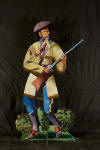
"William Cooke"
A Canadian soldier, he was Custer's adjutant that famous
day and it is his handwriting that is seen on the tiny scrap of paper at
the West Point museum which contains Custer's last, and most famous,
order:
"Benteen. Come on. Big village. Be quick. Bring pacs W. W.
Cooke
ps bring packs"
He wore long flowing sideburns, one of which was scalped
by a victorious warrior -- Wooden Leg. His body was re-interred in Ontario, Canada.

"George Yates"
Civil War veteran, he commanded Co. E and fell near
Custer on Last Stand Hill.
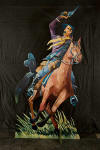
"Sgt. James Butler"
Butler's body was found a great distance from the other
dead troopers. A legend sprung up that maybe he was going for help and
had managed to get far away from the doomed soldiers before he was
killed. A large amount of empty shells were found around his body. Yet
how and under what circumstances he died are unknown. I am going to
celebrate the legend and place this figure of Butler not far from where he
was actually found; he will be chased by 3 mounted warriors.
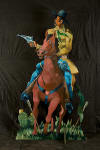
"Capt Myles Keogh"
Capt. Keogh riding his famous horse, Comanche. Keogh was
from Ireland (notice green neckerchief) and introduced the famous song,
"Garry Owen" to Custer who made it the regimental marching song. ("Garry
Owen" means "from Owen's garden" and it is a song about drinking and
creating a disturbance!) Keogh commanded Co. I, the "Wild I" as they were
known. Comanche was found alive and brought back to Ft Lincoln. The horse was never ridden
again and had the run of the fort, often enjoying his favorite drink, beer
from a bucket. His body is mounted and in a temperature controlled case
at the university in Lawrence, Kansas.
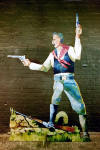
"John Jordan Crittenden"
Lt Crittenden fought with Company L and died on Calhoun Hill. By the
wishes of his parents, Crittenden, of all the soldiers who died on the
field that day, was the only one who remained buried in his original
grave. And so he remained until September, 1931 when he was reburied in
the Custer National Cemetery.
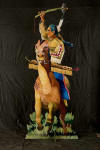
"Gall"
Famed Hunkpapa Sioux war leader. In the opening barrage
by Reno's men, Gall lost two wives and three of his children. In his rage he
rode into the fight armed with a war club (as seen here.) A powerful man,
he
weighed over 250 pounds ten years after the fight!
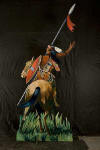
"Courier from Sitting
Bull"
This figure was stolen from the famous lithograph,
"Custer's Last Fight", which has adorned saloons and bars for over 100
years. It is my way of paying homage to all the artists who have gone
before me.
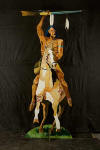
"Crazy Horse"
An Oglala Sioux, this most mysterious man was a fierce
warrior and notorious loner. Often he would ride off by himself,
returning days later with gory proof of having slain some Crow Indians or
white invaders. Of all the stories told about him, the most poignant one
concerned the death of his infant daughter. Returning from one of his
solo raids against the Crow, he was informed that his daughter had died
and had been buried in the traditional scaffold. Crazy Horse rode back
about 70 miles to the scaffold and climbed up into it and lay there with
her for three days in his sorrow. The story has never been verified, but it
does illustrate his unique sense of the world. He was murdered at Ft.
Robinson in Nebraska in September, 1877.
(Back to Top)
|

































